The only way to get material from Downsview is to order it by placing a hold request in LibrarySearch.
Downsview is a storage facility, so it is not accessible to library patrons.
The only way to get material from Downsview is to order it by placing a hold request in LibrarySearch.
Downsview is a storage facility, so it is not accessible to library patrons.
U of T Libraries provides an extensive collection of e-books, e-journals, e-articles and other electronic/digital content to its faculty, staff, students, and other authorized users. To do so, we must sign contracts with many different vendors and publishers of the e-content. Contracts contain specific terms and conditions that users must comply with, when accessing and using the e-content.
The terms of use are not the same for all e-resources. Therefore, each licensed article, book, or journal has its particular terms listed in the record for that item. Terms dictate if the user can print a copy, or share it with a 3rd party for scholarly use, or other actions, as described more fully on this UTL information page.
The record for the e-book Robots, published by MIT Press and available to users from the IEEE Xplore platform is shown below. Next to the name of the provider of the electronic content, you can click on the SHOW LICENSE link to see the terms for this e-book.
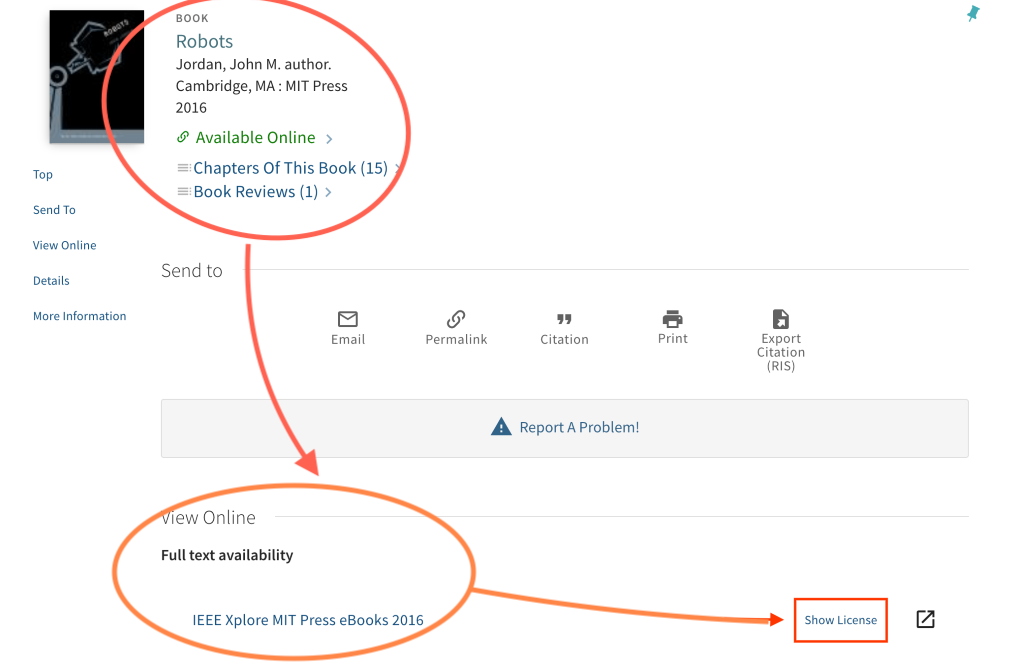
Clicking on the SHOW LICENSE link reveals the terms, as illustrated below.
So, users may print a portion of this book, but the book cannot be uploaded to Quercus, since Course Reserve Electronic Copy is prohibited. Providing a direct link to the resources is permitted.
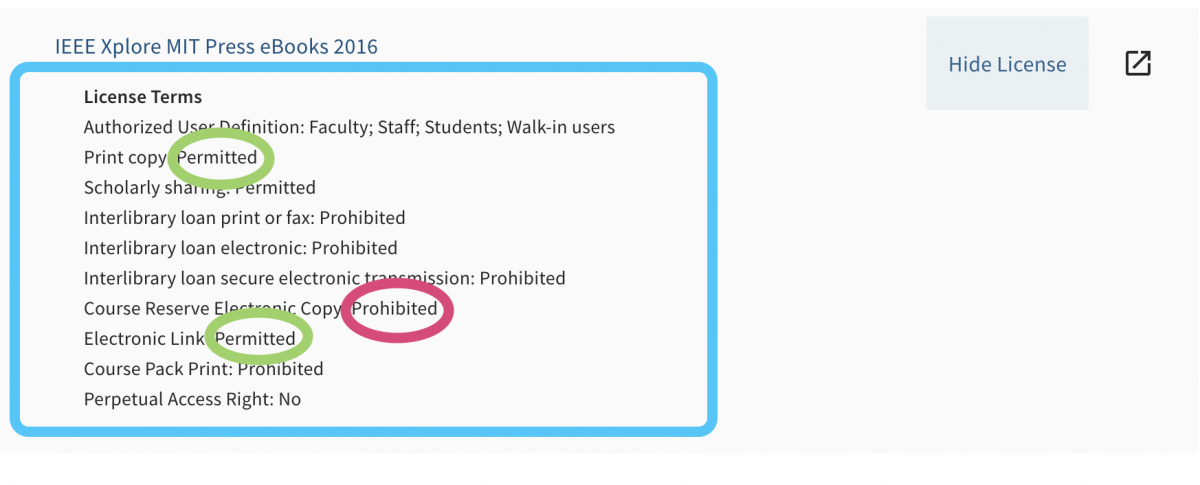
Read more about using licensed library e-content. Users who need more clarity about license terms can contact library.licensequeries@utoronto.ca
Yes! Cut and paste the ISBN (for books) or ISSN (for serial publications such as journals) into the LibrarySearch search box.

If we have the book you're looking for, it will show up in the search results.

Notice that while this book is available in Robarts Library stacks, it is also available electronically via our current HathiTrust agreement. To see it electronically, click on the link and then login into HathiTrust with your UTORid and password.
If no book is found, check that you have the correct ISBN. If we don't have the item in our collection, you can borrow it from another library through interlibrary loan.
Yes you can. LibrarySearch has a citation generating feature, with seven citation styles to choose from.
Find the book or article you wish to cite, click on the ellipsis (...) in the upper right of the individual item record to open up a set of icons – email, permalink, citation, and more.
Click on CITATION, choose a citation style, then cut and paste the results, as shown below.
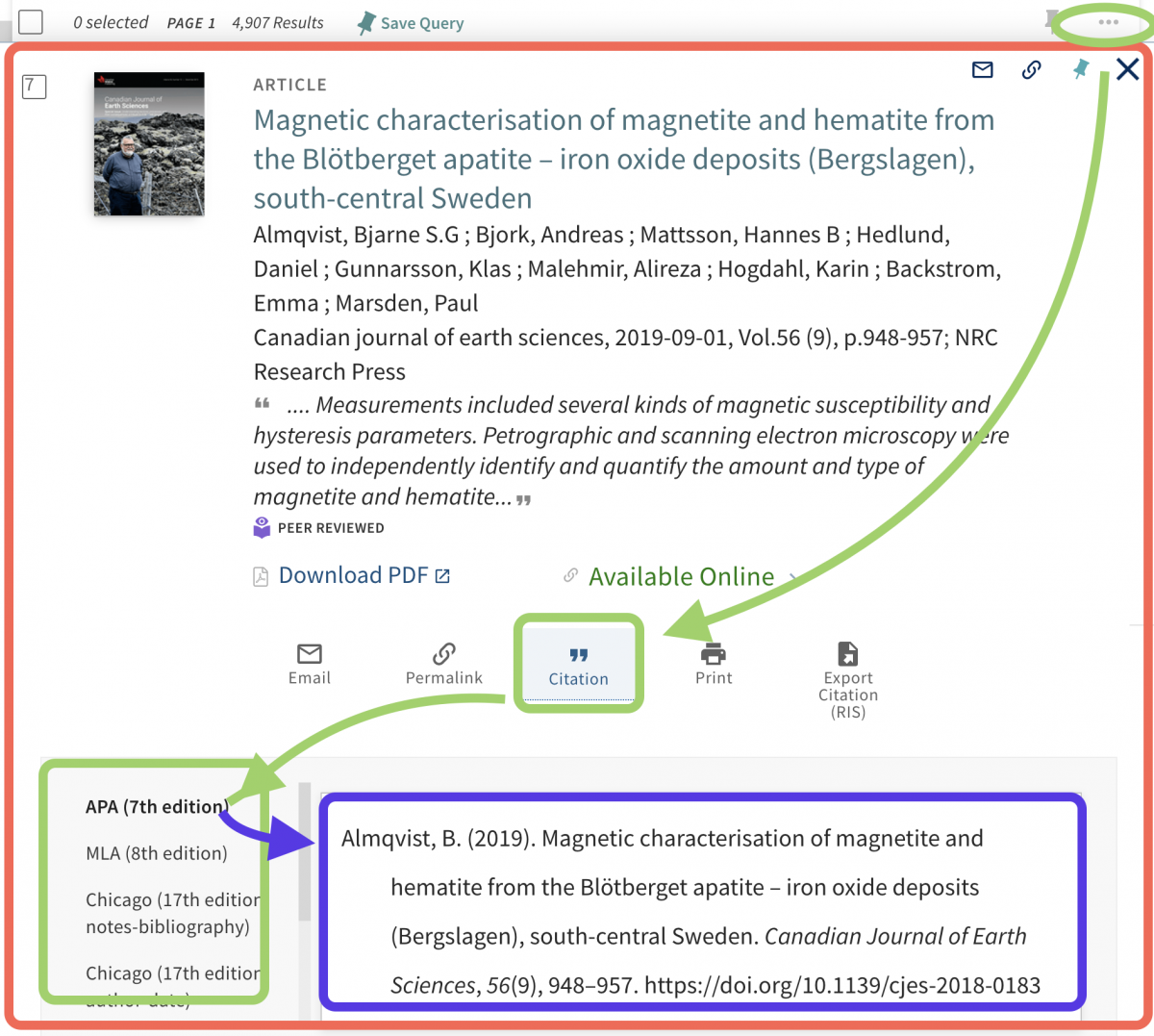
ALWAYS check the generated citation to make sure it is fully correct. In the above example, APA 7 requires all authors up to 20 be listed, and the first author should be Almqvist, B. S. G.
For more information on using all the many features and functions of LibrarySearch, have a look at this guide on using the new system.
Yes, you can! Paste the part of the DOI that comes after https://doi.org/ into LibrarySearch. DOIs usually start with the number 10.
If the search mode is visible, leave it as "Everything".

Find articles by DOI outside of LibrarySearch using LibKey.io.

Look up your textbook in the library catalogue to see we have a copy. Your instructor might also have put it on course reserve.
Several different systems are used to arrange books on the shelf across the University of Toronto's 40 libraries.
In general, all of these systems are designed to:
Subject headings are similar to tags or hashtags. They describe the topic of an item in a database, but unlike tags, they come from an official, standardized set of terms and are assigned by cataloguing experts.
You can use subject headings to:
There are several kinds of subject headings used in library databases. They can be subject-specific like the Medical Subject Headings used in Medline or more general like the Library of Congress Subject Headings used in the library catalogue.
 Not all databases use subject headings. JSTOR, Web of Science, Summon, Google Scholar, and Scopus all don't use them.
Not all databases use subject headings. JSTOR, Web of Science, Summon, Google Scholar, and Scopus all don't use them.


There are multiple ways to find a book by its title.
Type the title of the book in double quotation marks into the LibrarySearch search box on the UTL homepage.



Use the following settings:
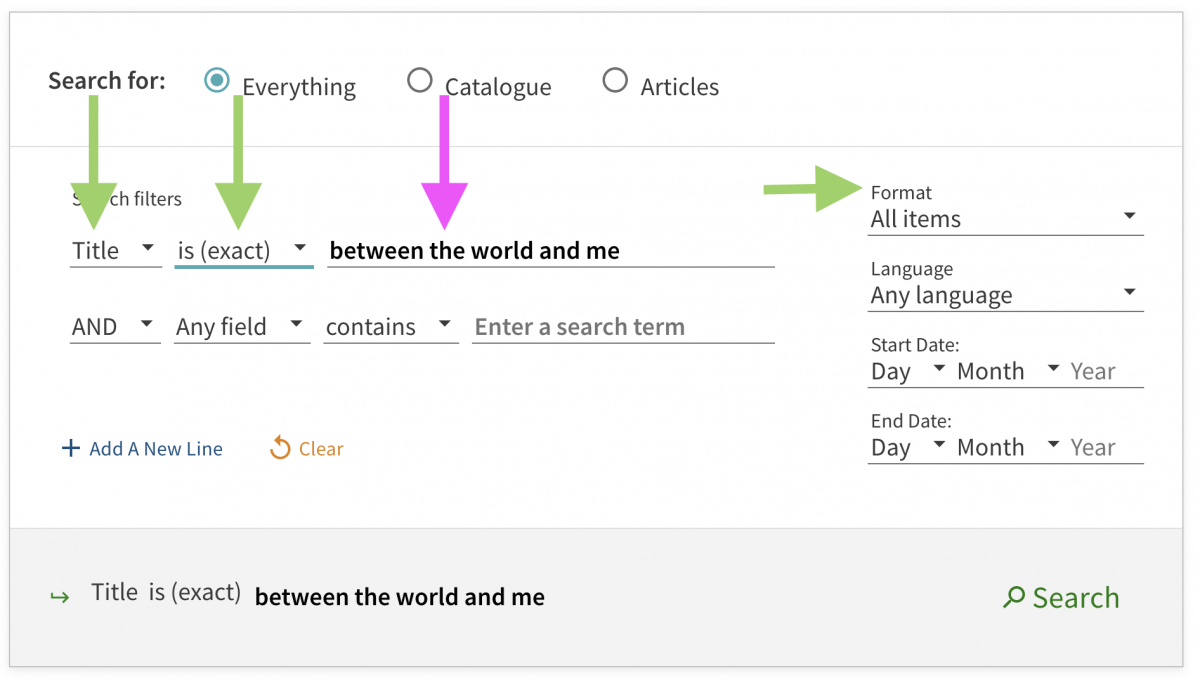
For more information on using all the many features and functions of LibrarySearch, have a look at this guide on using the new system.
You can enter the journal title in double quotes into the LibrarySearch search box on the U of T Libraries homepage.
A more direct way is to use the journal search function available from the LibrarySearch interface.
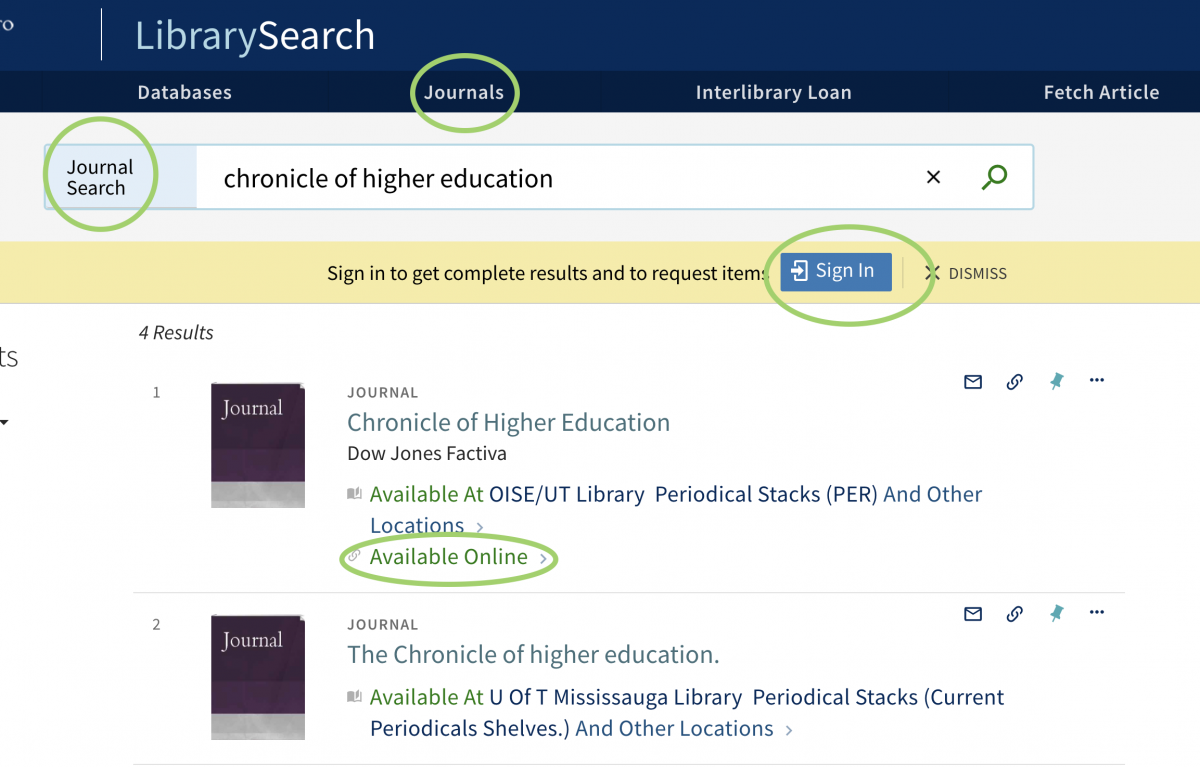
You can also find journals by searching as you would for books, that is, by choosing to search the CATALOGUE, or EVERYTHING.
For more information on using all the many features and functions of LibrarySearch, have a look at this guide on using the new system.
To find an article by its title, type the title in double quotes into the search box on the UTL homepage. This will search for the title as a phrase.You can also go straight to LibrarySearch and type the article title in double quotation marks. Make sure to select ARTICLES and click on the magnifying glass icon to search.
See also: Find articles & books by DOI
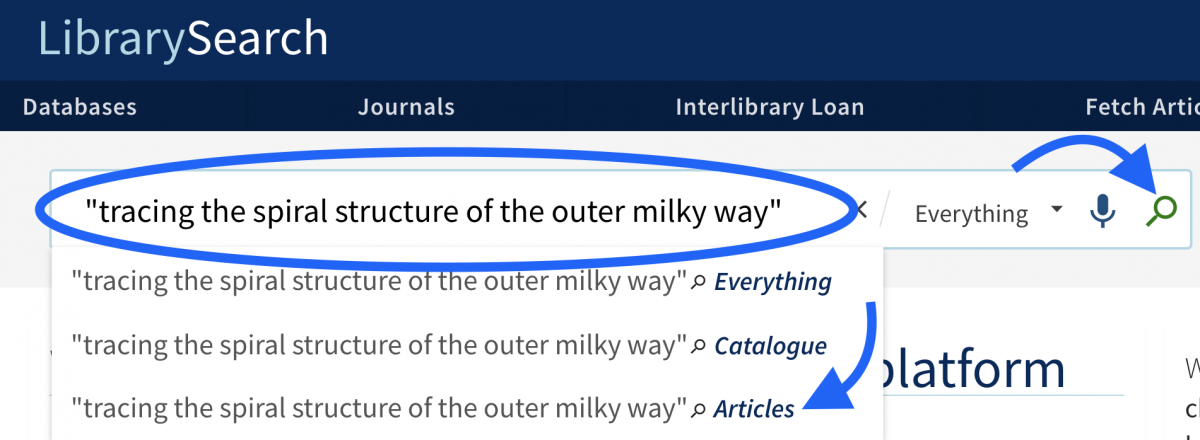
The individual article record contains many features and functions as shown below. Click on the ellipsis (the three dots ... to the upper right) to bring them up.
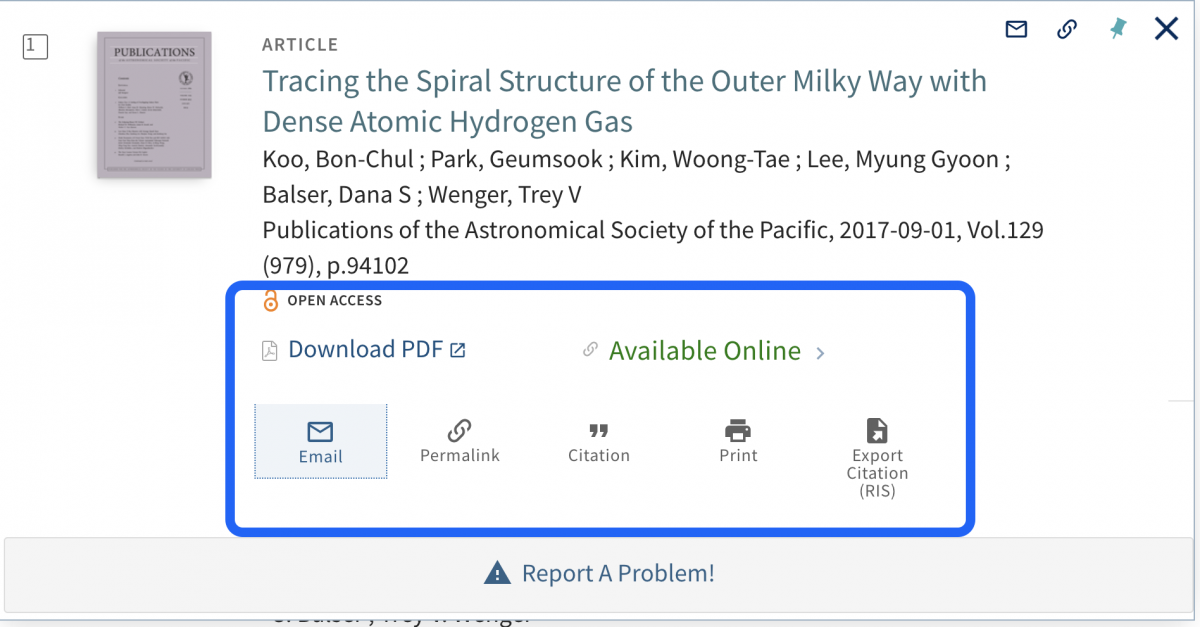
Other helpful features in the article record:
For more information on using all the many features and functions of LibrarySearch, have a look at this guide on using the new system.
Search for your title or topic in the LibrarySearch search box, leaving it set to EVERYTHING.
Click ONLINE in the SHOW ONLY filter, then click BOOKS in the FORMAT filter.
You can select more than one filter at once. Then click on APPLY FILTERS.
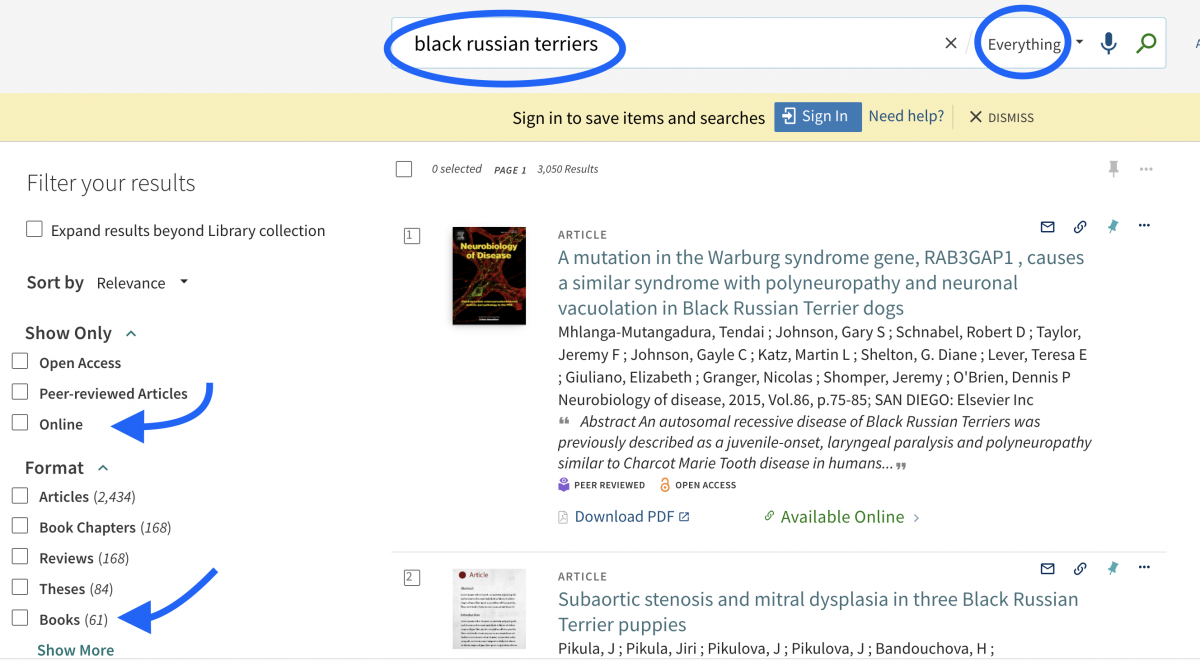
From the resulting list, you can see e-books that mention this breed of dogs.
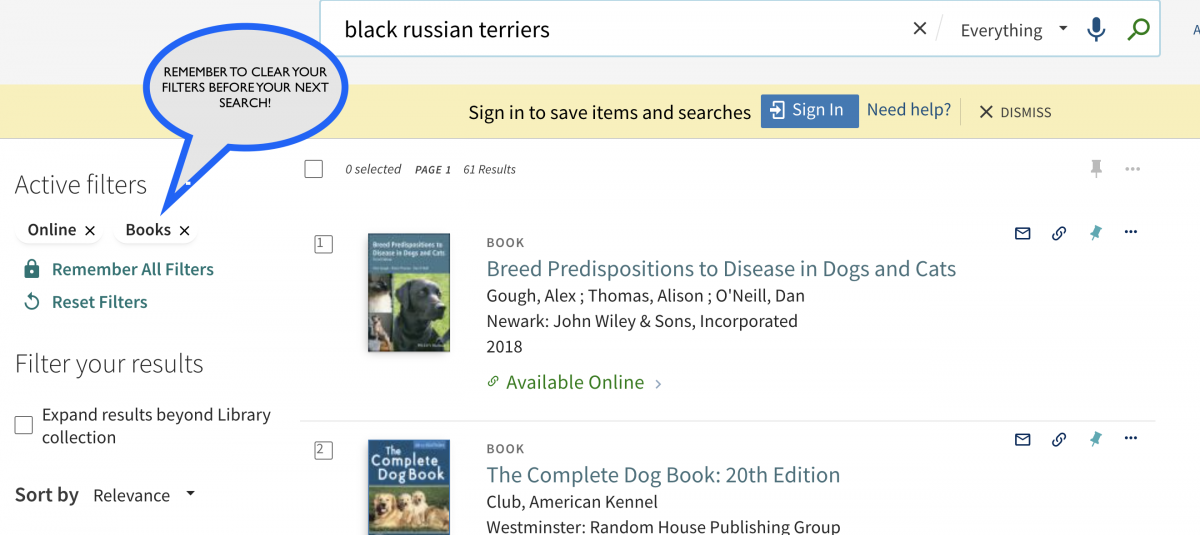
Three good ways to find books by author are:
1) Type author name directly into LibrarySearch search box on the UTL homepage
2) Use the ADVANCED SEARCH mode
3) Use the BROWSE feature.
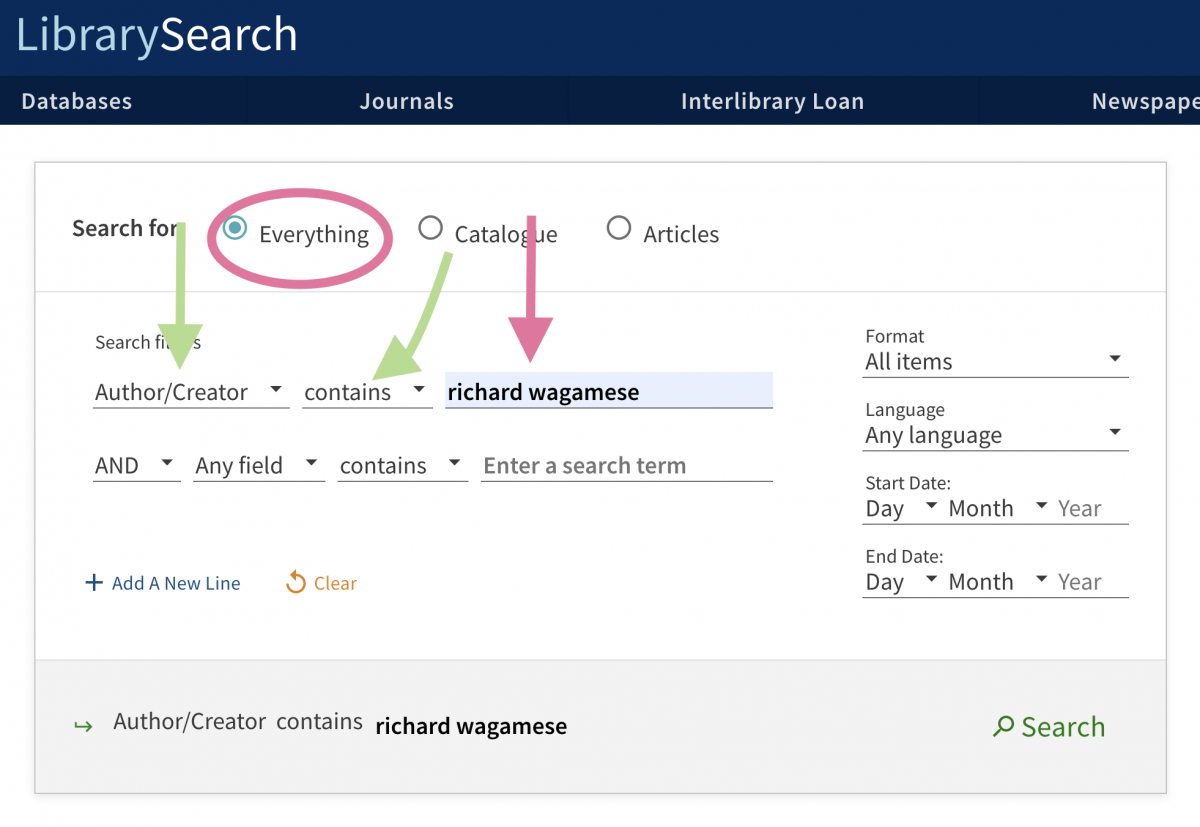
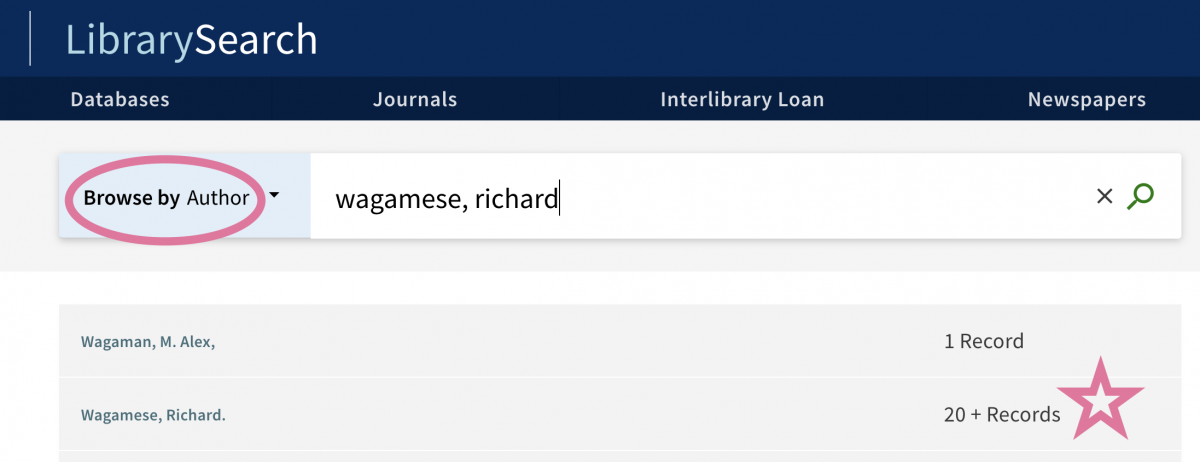
For more information on using all the many features and functions of LibrarySearch, have a look at this guide on using the new system.
1. Find your book by looking in the catalogue part of LibrarySearch, then look for the link icon in the book's catalogue record.
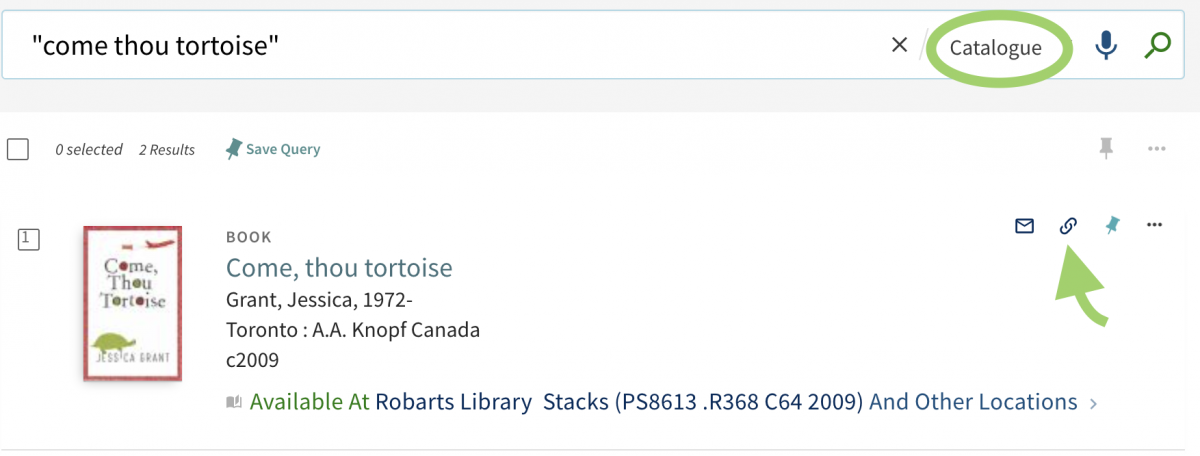
2. Click on the link icon to open up the window that contains a permanent link to the catalogue record for this book. A permanent link is also known as a permalink, or a durable link.

3. Cut and paste the link into your email or other document.
1. Find your article in LibrarySearch, remembering to choose Articles.

2. Click on the link icon to open up the window that contains a permanent link to the article record

3. Cut and paste the link into your email or other document.
For more information on using all the many features and functions of LibrarySearch, have a look at this guide on using the new system.
You can search for items by name of publisher in ADVANCED mode of library search, as in example 1.
You can also add other criteria to the search by selecting a date range, or searching for similar titles of books from one publisher, as in example 2.
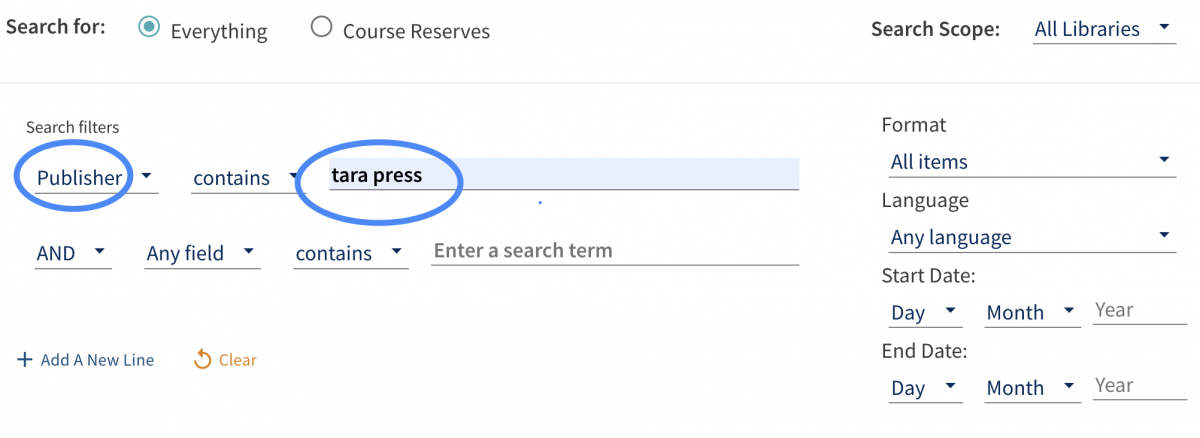
Results show books published by Tara Press in New Delhi.
From here you can use the filters on screen left to see ONLINE items only, or change the sort to newest first, or see what items by Tara Press are in Robarts stacks.
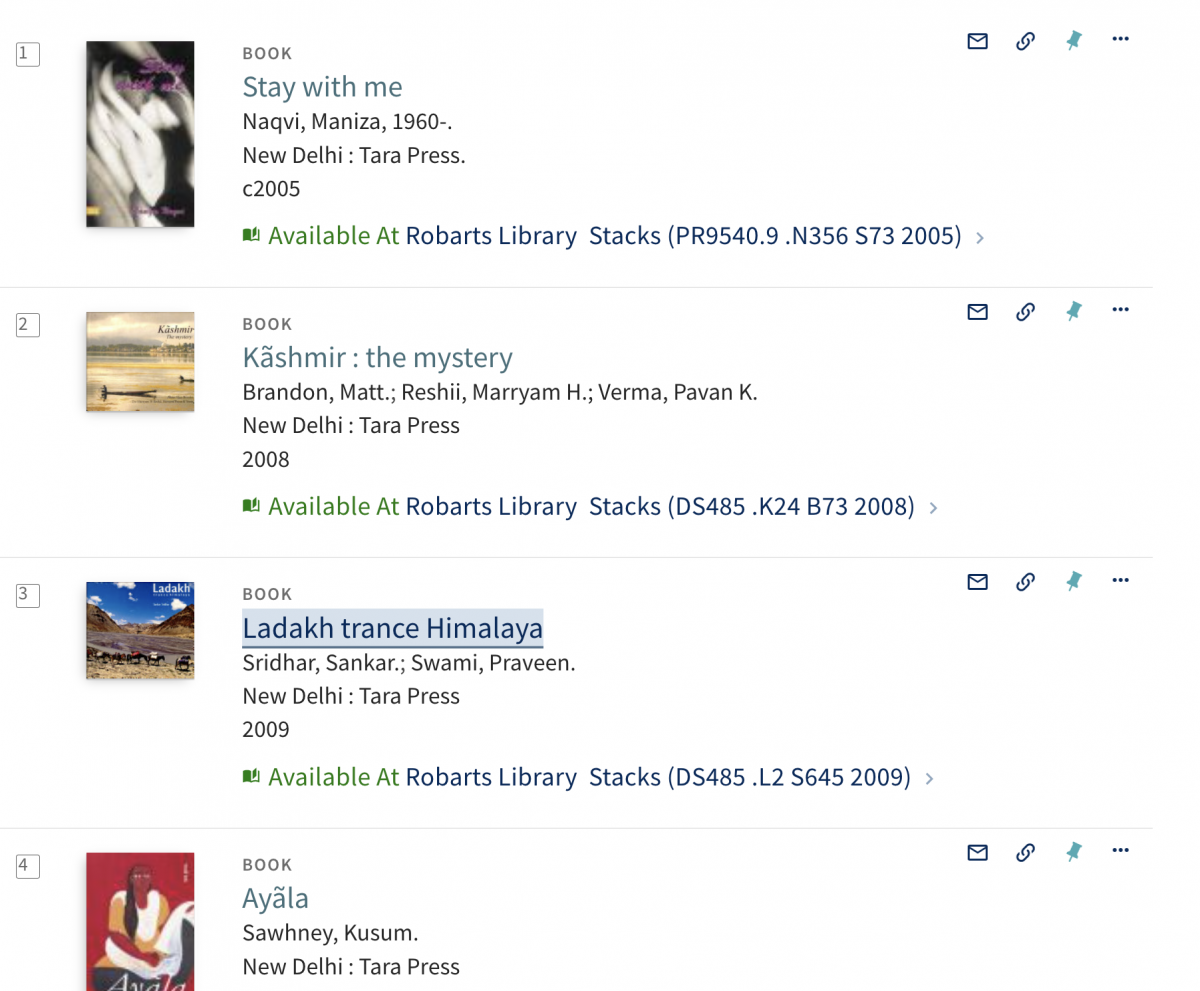
Oxford University Press publishes excellent handbooks in many subject areas, with titles following the form 'The Oxford handbook of [something]'.
This is how to search for all Oxford University Press handbooks.

You can then filter to show only ONLINE items. Here are the first four results found by such a search.
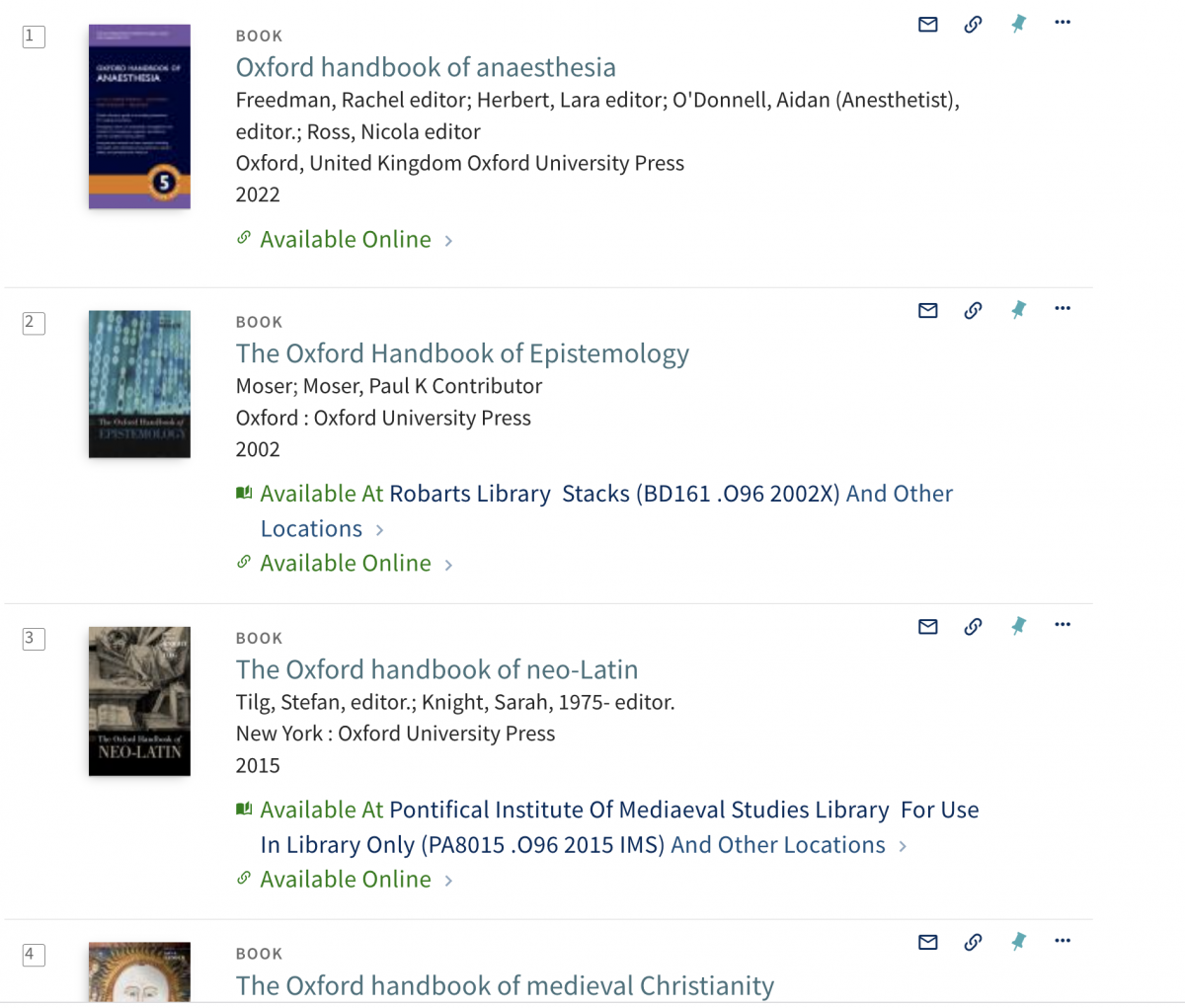
A Course Reserves search has been added to LibrarySearch.
As you start typing search words, you can choose to search for those words in just items placed in Course Reserves.
Search words can include the name of the course instructor as well as the course code and title.

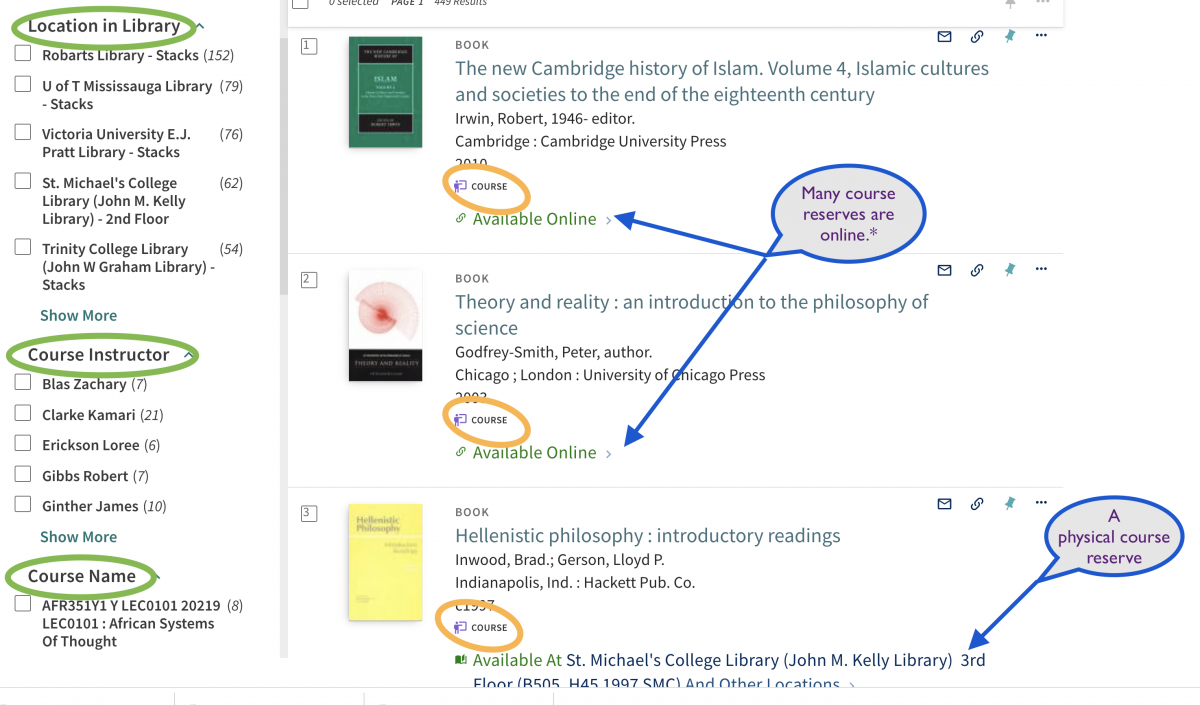
In January 2021, the library upgraded to a new system. Before then, you had to search for items in our collections – called the 'catalogue' – course reserves, and articles, separately.
Our new tool, LibrarySearch, searches all of these at once though a user friendly and mobile-responsive interface, and it has more functionality than the previous tool.
For example:
For more information on using all the many features and functions of LibrarySearch, have a look at this guide on using the new system.
There are numerous reasons why a book may show as available in LibrarySearch, but not actually be on the shelf. Locate the sorting shelves on the floor, and check to see if the item is there.
In Robarts sorting shelves are in middle of the yellow section on each stack floor.
At Gerstein sorting shelves are near the elevator on level 1 and 2 below: as you face the elevator, look to the right to find the sorting shelves. The library asks that you check the shelves at least twice before placing a search at the Loans Services desk on the main floor.
This will vary from library to library.
If the item is not on the sorting shelves, you can place a hold request on the item to prompt staff to search for it. If the item is still not found, it will be marked missing.
Yes! We can suggest several strategies.
By signing in with your UTORid and password when you are using LibrarySearch, you are authenticated as a U of T user for the rest of your browser session. This allows you access to U of T licensed e-content, such as articles, databases, or e-books.
Install a browser extension called LibKey Nomad. It will link you to the PDF of articles owned by U of T or Open Access whether you start your search on the library's website or not.
Make sure Google Scholar knows you're a U of T user. Once you change your settings, you'll see "Get it! UTL" links next to articles in your search results.
If you have an e-resource bookmarked, make sure that the URL has http://myaccess.library.utoronto.ca/login?url= at the front of it. That will authenticate you as a U of T user and give you access to our online content.
If you're on a journal or ebook website, try pasting http://myaccess.library.utoronto.ca/login?url= in front of the URL you're currently on. You will be asked to log in with your UTORid.
![]() This only works if the library actually subscribes to the journal. You can search our catalogue for the journal title or ask us for help.
This only works if the library actually subscribes to the journal. You can search our catalogue for the journal title or ask us for help.
Our new tool, LibrarySearch, searches for books, e-books, articles, journals, course reserves, DVDs and other audiovisual material, and other items in our collections all at once though a single user-friendly interface.
From the library homepage:

Once you are already in LibrarySearch:
You can choose to search just in the CATALOGUE, or just for ARTICLES. Choosing to search EVERYTHING searches both the catalogue and articles.

There are a few things that are not included in LibrarySearch, however.
Use the WebsiteSearch search box to look for content about the library and our services.

This includes:
WebsiteSearch does not search for books, articles, journals, audiovisual materials, and other content that the library owns or subscribes to. Use LibrarySearch instead.
Reference books and reference sources are not meant to be read cover to cover. They are used to locate specific facts and background information.
Examples of reference books or reference sources include dictionaries and encyclopedias; however, there are many kinds of reference works in a library collection, as this table illustrates.
| Type | Description |
|---|---|
|
Almanacs |
An annual publication of practical dates, facts, and statistics, current and/or historic. Example: The Military Balance |
|
Atlases |
A bound or boxed collection of maps, usually related in subject or theme, with an index of place names usually printed at the end. Example: Historical Atlas of Hasidism |
|
Bibliographies |
A publication that lists written works by a specific author or on a given topic, or that share one or more common characteristics (language, time period, place of publication, etc.). Example: Rap/Hip Hop: Oxford Bibliographies |
|
Biographical sources |
Works that describe the life of people who share one or more common characteristics (identity, profession, place, time, ect.). Example: Who's Who in Gay and Lesbian History |
|
Catalogues / catalogs |
An organized list of items in a collection, an exhibition, or other intentional gathering of materials. This work often provides brief item-level descriptions of physical or other relevant characteristics. Example: A Catalogue of Greek Manuscripts |
|
Concordances |
An alphabetically arranged list of the principal words or selected words in a text, or in the works of an author, giving the precise location of each word in the text, with a brief indication of its context. Example: A Concordance of the Qur’an |
|
Dictionaries |
A single or multi-volume work that contains brief explanatory entries for terms related to a specific subject or field of inquiry. Entries are usually arranged alphabetically.. Example: Oxford English Dictionary |
|
Directories |
A list of people, companies, institutions, organizations, etc., often in alphabetical order, that provides contact information and other relevant details. Example: The Grants Register 2022 |
|
Encyclopedias |
A book or set of books containing authoritative summary information about a variety of topics in the form of short essays, usually arranged alphabetically by heading. Example: Women and Gender in Medieval Europe |
|
Glossaries |
A publication providing an alphabetically arranged list of specialized vocabulary of a given subject or field of study, with brief definitions. Example: Glossary of Morphology |
|
Handbooks |
Single-volume publications that provide concise factual information on a specific subject, organized systematically for quick and easy access. |
|
Indexes |
An alphabetically arranged list of headings consisting of the people, places, and subjects covered in a written work, with page numbers to refer the reader to the point in the text at which information pertaining to the heading is found. In large multi-volume reference works, the last volume may be devoted entirely to indexes. Example: See any multi-volume reference work |
|
Style Guides |
Resources that describe a set rules and guidelines for writing in a variety of contexts. These works include descriptions of how to cite, how to format a paper or a reference page, what font to use, what size that font should be, and much more. Example: Publication Manual of the American Psychological Association (APA) |
Note: This list of reference works by type is not exhaustive. Please use LibrarySearch to discover others types and formats.
Book your research consultation here.
Fill out our Book a Research Consultation form.
Make sure you tell us the campus, department, or course code associated with the project or assignment you’re requesting a consultation for. Knowing this will help us connect you to your liaison librarian, library staff member, or other subject matter experts in your field!
An expert (librarian, library staff member, etc...) will reach out to you after you submit your form.
After submitting the Book a Research Consultation form, we will match you with an expert who will reach out to you by email.
When they contact you, they will arrange a time and place to meet you – online or in person – that fits your schedule.
When you’re replying to them, you can give them more information about the specific issues or questions you have that you want to address in your consultation.
We use this information to make sure that we're matching you with an expert in the field you're studying, and ideally, someone who's on the same campus as you.
We prefer a course code if you have one, but we know that some people are looking for thesis and other kinds of research assistance. We'll reply to your submission via email if we have more questions/if we need to clarify details like this.
If your consultation is happening in-person, have ready:
If your consultation is happening online, have ready:
Your liaison librarian, staff member or subject matter expert will tailor your research consultation to meet your needs and will help you develop you research skills and knowledge in your subject area.
During your research consultation, you may discuss:
Every research consultation is different, so this will depend on what your research question is!
You will be asked questions to get a better sense of how much research you’ve done, the ways you currently library resources, and other ideas relevant to where you are in your process. Some questions you may be asked include:
Questions like these are asked to make sure your librarian can help you best. There are no right or wrong answers!
If you need more assistance with library resources, contact us!
If you’re looking for academic writing help, there are Writing Centres across our three campuses that provide individual consultations with trained writing instructors, along with group teaching in workshops and courses.
If you’re looking for ways to further yourself academically, consider contacting the Centre for Learning Strategy Support (CLSS)’s Peer Mentor service!
You can search the catalogue for:
To find electronic articles choose 'Articles' in the drop down menu in LibrarySearch.
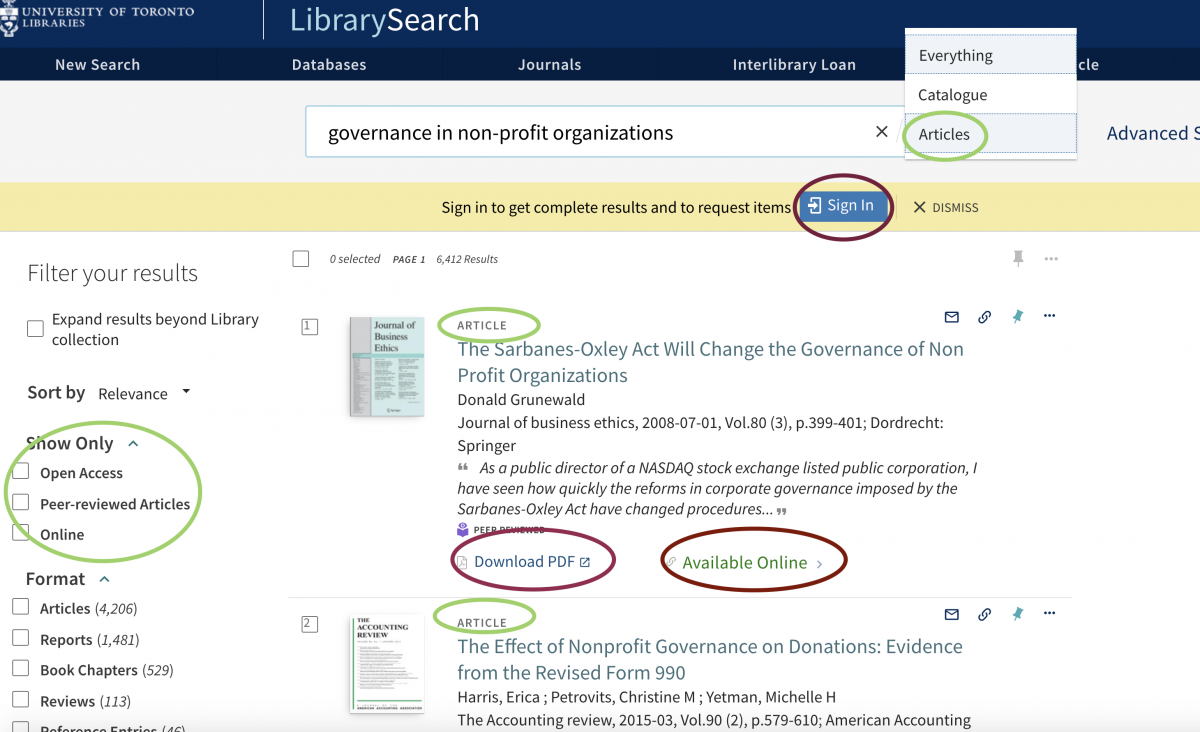
To find databases choose Popular databases or Subjects A-Z from the library's home page.
